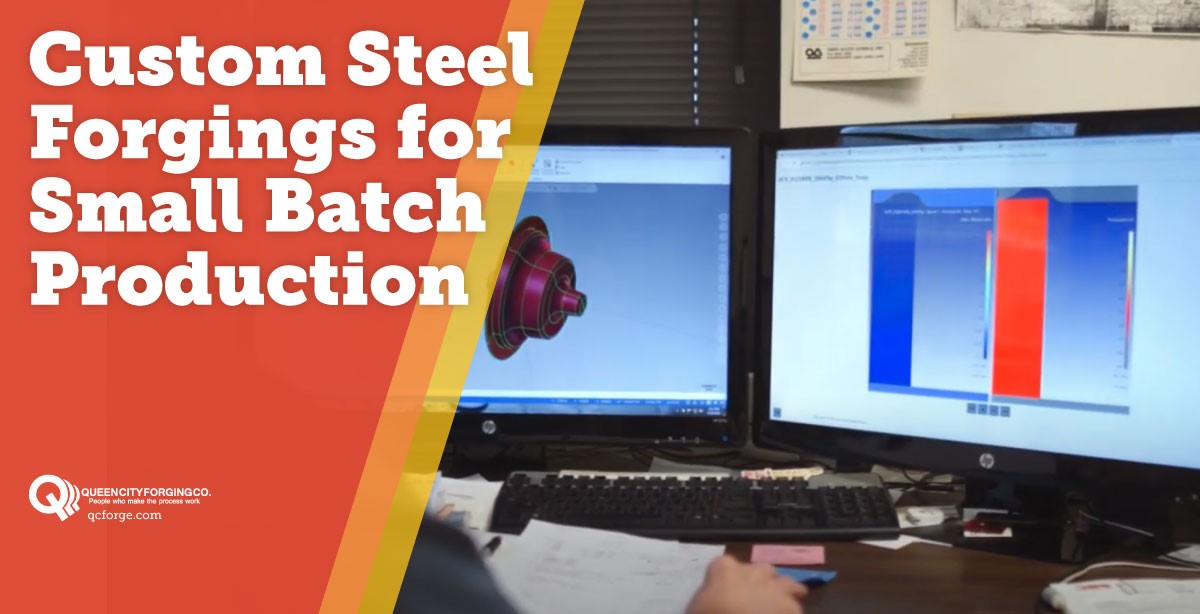For over 135 years, Queen City Forging has been a leader among U.S. forging companies, providing metal components that solve challenging manufacturing problems, and preventing product failure that threatens success in a competitive marketplace.
Queen City Forge makes the world’s most reliable metalworking process work to produce medium to small metal component parts that must not fail in the most severe conditions and critical situations. Our metalworking process creates the most durable components available for use in manufactured products; from electrical relays to ICE turbochargers; from agricultural implements to aircraft fittings; from hand tools to CT scanning machines.
Wherever there is concern for safety and reliability, wherever the ultimate in strength and durability must be achieved, you have a need for the processes we have mastered.
Custom Steel Forgings for Small Batch Production is critical for prototyping, testing, and designing quality products. We are constantly working toward improving our time to production of a quality product with less resources, tools, time and cost.
Finite Element Engineering (FEM) Programs
FEM programs have been used and improved over many decades to predict and modify the forging process. A tension remains in the balance between the predictions from computational modeling/simulation (CMS) and understanding the correct inputs and recognizing valid outputs when using such design aids.
Experience and understanding gained from years of working metal is critical to knowing if the FEM program is producing a useable result. Addressing the need for continued improvement to enhance CMS programs, organizations such as the Forging Industry Education and Research Foundation (FIERF), and the Forging Defense Manufacturing Consortium (FDMC) have funded projects seeking to make them more “expert”, including the application of artificial intelligence (AI).
 The goal is to reduce the time required for an engineer to acquire the experience needed to create valid forging and forging tool designs. The intention is to reduce the production time and cost for short run requirements. This is a critical issue for prototype production, small production lots, or where there is a need for low volumes of spare parts where tooling is no longer available many years after an initial acquisition program.
The goal is to reduce the time required for an engineer to acquire the experience needed to create valid forging and forging tool designs. The intention is to reduce the production time and cost for short run requirements. This is a critical issue for prototype production, small production lots, or where there is a need for low volumes of spare parts where tooling is no longer available many years after an initial acquisition program.
Queen City has been part of the effort, seeking better ways to bring the strength of the forging process to lower volumes of critical components. FEM assists and speeds the design process. Various machining technologies can speed die manufacture. An additional improvement under investigation is potential for use of various additive processes to create preforms that could eliminate several forging process steps without sacrificing forged quality.
Forging typically requires multiple shaping and forming steps. This may require multiple dies and a series of thermal/forging cycles between die changes which can be detrimental to ultimate metallurgy. Alternatively, the forging process may require larger dies to accommodate multiple forging stations and larger forging equipment to perform a series of progressive forming steps. A preform consolidated by an alternative additive process may allow as few as one final forging station, building upon the additive consolidation to achieve cost effective true forged quality with a single cavity die.
The more complicated the die, the greater the potential benefit using the technique of starting with an additive process for preforming. Additive preforms may also provide means to create cost effective, unique alloy, forged configurations. Rather than being limited to the standard commercially available alloys or needing to bear the extraordinary costs of producing special alloys with equipment mismatched to the end requirement, additive processes may allow maximum efficiency in use of expensive constituents lowering both input and scrap costs. A streamlined conversion process requiring fewer steps should also reduce thermal and mechanical cycles, not only saving energy but also assuring metallurgical design properties are achieved.
Filed under: Forging Innovation, Forging Parts, Forging Process



